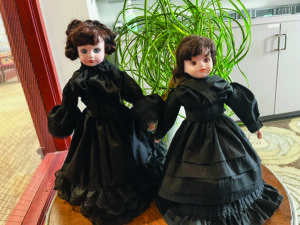
By Ashli Cean Landa / Featured image by David J. Turner
When English professor Andrea Kaston Tange announced to her nineteenth-century British literature class that they would be sewing mourning dresses for two fifteen-inch dolls, she was pleased to discover that most of her students were excited by the idea.
So she was surprised by how quickly the enthusiasm faded once needles were in hand.
“After one day of working, there was kind of a rebellion,” she says. “They were like, ‘this is hard! We don’t want to do it!’ and I was like, ‘hard is the point!’”
The “Ladies and Monsters” class was studying Mary Barton, an 1840s novel set in the textile-industrial north of England. Tange wanted the project to help “make the past less of a foreign country” by having students participate in common labor of the time.
“If you’re talking about a time before sewing machines, it’s almost impossible to get your head around the actual labor of living unless you try your hand at it,” she says.
In the book, a character is tasked with sewing four (human-sized) mourning dresses in roughly thirty-six hours. Tange estimates that it took the class forty to fifty hours to finish the two doll-sized recreations, which included a quilted petticoat, skirt, and bodice.

“We’d be sitting in discussion talking about the book, and people kept raising their hands and [Tange] would say, ‘Book question or sewing question?’ and they’d sheepishly say ‘Sewing…’ and we’d all giggle because we had no idea what we were doing,” Gavia Boyden ’26 (Seattle) says.
Tange also designed the project to encourage students’ engagement with the novel through a contextually comprehensive lens.
“Thinking about material processes and day-today lives is crucial for understanding the conditions in which these books were written,” she says. “The conditions in which they would have been originally read—who has the luxury of reading them and who doesn’t, who’s represented and who’s not—it changes how you read.”
Tange’s students say the lessons were received loud and clear. Peyton Williamson ‘27 (Austin, Texas) was “completely baffled” by the amount of work a character her age was expected to do.
“It really puts into perspective how much technology we have at our disposal now to do hard labor,” she says. “Sewing is easier talked about than done.”
As difficult as learning to sew and discussing literature at the same time was, students and professor both say the final product—and the shared experience of creating it—was well worth the effort.
“When they suddenly had the whole doll in their hands and were able to look at the layers, the finished edges, the teeny little stitches on teeny tiny hems— there was this quiet that went around the room,” Tange shares. “They all looked a bit in awe by what they’d accomplished.”
“My favorite aspect was getting to know and connect with my classmates as we sat in a circle, pricked our fingers, and laughed as we struggled to thread a needle,” says Boyden. “It amazed me how possible it is to form a community over even a small labor of love.”
August 26 2024
Back to top





